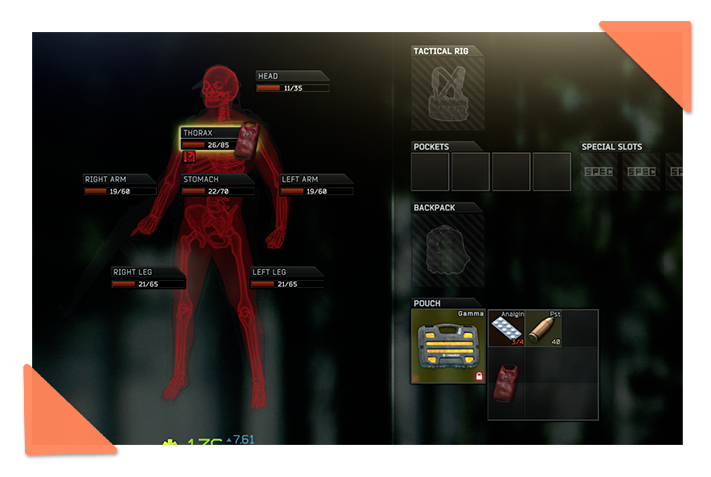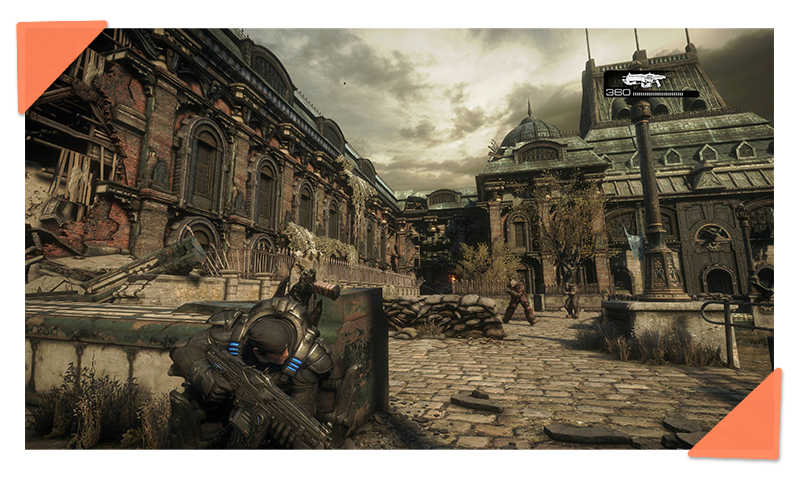Can We Replace Silly Health Systems?
Humans definitely don’t work like that.
Did you ever stop and thought about how unrealistic health systems can be?
Most character-based games use an arbitrary points system to classify the varied type of injury & heal. Equip a new armour to increase your HP limit by 10, lose 35 when falling from a cliff, eat a loaf of bread to restore 50. It doesn’t make sense, and yet it’s everywhere; we’re accustomed to it.
While the past decades of gaming have brought many innovations destined to increase immersion & recreate more accurately our world, it feels odd that we don’t question the relevance of this mechanic anymore. Everybody (myself included) accepts this feature, and nothing seems to be able to replace it.
So, why is the health mechanic universal and can nobody invent something else?
All Games Are Immersive
I love to begin my analysis with a (too) broad statement, so here’s one: 95% of games attempt to be immersive.
When we exclude experimental art projects and look at commercial game genres, one could define video games as “pieces of software whose primary goal is to deliver quality entertainment by allowing players to escape reality.” Games, by definition, create a separate reality driven by rules that are necessarily distinct from ours. The game rules give a new cohesive meaning to the visible items, the displayed numbers & the pixel on our screens.
Virtually every human on earth is also a player (at least as a child), with unique tastes regarding the genre & types of experience they like to engage with. In particular, each person may appreciate different levels of abstraction & distance from the reality they know. Still, it’s fair to state that most games help the player get immersed in a new “reality” by relying on existing knowledge & leveraging concepts they can immediately grasp. Even chest.
At a basic level for instance, most video game genres involve controlling a single avatar who can interact with the play area: it makes immersion easier, because that’s also how we, humans, experience life. Our world is full of rules we grasp intuitively, such as the law of gravity or that fire burns things.
Simulating those rules is a way to blend the frontier between game & reality, thus facilitating our acceptance of the unique twists the game has to offer. If everything is new, the step is too high, and we have difficulty approaching the experience.
However, our world is complex, so the difficult task of game designers is to simplify the real-life mechanisms while keeping their essence. Over the years, we stumbled upon pretty good approximations of our reality. For example, a stamina bar is a decent model representing how humans can sprint short distances before they need to jog/walk to rest. Hunger is another example I like: it’s ‘realistic’ that the sentiment of fullness decreases over time until the lack of food feels painful and has a physical impact.
Meanwhile, health feels poorly represented when it’s often just a simple pseudo-economic system where different actions cause your “health bar” to go up or down. Why do you lose the same arbitrary amount from a gunshot as an explosion? How does eating food heal your burns? Looking at the health mechanic through an immersion lens can’t explain the standardized form it usually takes.
Who Needs Health?
If we observe how health works in real life, and I don’t mean after earning a medical degree, we may create various smaller mechanics to represent different bodily functions. This is the approach taken by the popular extraction shooter Escape from Tarkov with seven separate meters whose status can influence movement speed or vision.
This is a more complicated version of the traditional health bar, yet still ends up centralizing a variety of inputs (damages) & outputs (maluses) with its own logic of states & effects. Ultimately, though, the system has the same goal as simpler ones: tying all the “negative” actions to a common defeat condition, because it helps players make sense of the rules.
In a way, directing all the attention to an abstract “health meter” makes as much sense as unifying the varied “positive” actions in a single scoring system. Losing your avatar is the ultimate punishment a game can inflict on its player since you literally can’t experience the entertainment anymore.
No need for heavy consequences, sometimes, restarting a couple of seconds earlier is enough of a threat to push you to engage with the features designed to help you survive (such as a cover system) and generate tension.
Even games who seek maximum immersion have to forfeit a certain degree of freedom to players (or they’d be movies), hence the need to have mechanics to communicate boundaries & re-create intuitive logic. Rather than putting an invisible wall, I’m going to let you jump out of the window, but you’ll lose health because gravity hurts.
Health takes this form in games because its main role is to communicate limits efficiently, and the infinite complexity of -actual- human health isn’t a suitable candidate.
The Injury System That Didn’t Work
So, if we shouldn’t reinvent the health mechanic each time, maybe we could just enrich it? That’s the question some of my former colleagues on Ghost Recon: Breakpoint had to answer when they were tasked by the direction to introduce an injury mechanic.
The creative director’s idea was to reinforce the theme of the military squad behind the enemy lines and introduce injuries to raise the tension. For instance, while limping, your speed was massively reduced, and you could only shoot with a handgun. The sudden change of controls would (in theory) force the player to go to cover to apply a bandage, giving enemies a chance to close on him… but it never really worked as intended. You’d typically either die shortly after the injury came or could comfortably use the bandage.
Moreover, if you didn’t have a bandage in inventory, you’d limp for very long minutes until finding a bivouac spot, which wasn’t a fun experience for any of the playtesters. You had “successfully survived” the encounter, yet it felt more like a punishment, and you’d wish you died & respawned instead.
Of course, this raises many debates in the team about the fun of the experience and how to account for maluses. Deserved or not, applying negative effects to the player is always a difficult design decision, because everyone has a tolerance threshold for frustration.
After many iterations, the eventual solution to this design problem was turning the bandage into a permanent inventory item while adding a consumable “quick-heal” syringe. This still rewarded the cautious players who prepared their loadout and was less than punishing for those who didn’t. However, it also decreased the intensity of the experience too, but it probably wasn’t the right game to introduce such hardcore mechanics anyway.
Conclusion
In the end, even though I didn’t work on the mechanic directly, seeing the process & the iterations helped me realize that the lack of “deep” health systems isn’t a design oversight. When the game takes away some of the avatar capacities, it’s rarely a great experience, so it must be handled cautiously.
I’m not saying it can’t be done, there are certainly great games with inventive health systems. However, when a mechanic is that powerful and omnipresent, there is always a good reason. When the ‘defaults’ serve us well, there’s no need to reinvent the wheel (even if we often love to as designers!)
If you liked this issue, you may also enjoy that one:














This is a subject I find very interesting (And you may or may not have made me buy Escape from Tarkov), I've always thought up games where injuries would be localized and it would be somewhat realistic.
Some games with zombies have the approach of making them invulnerable unless you shoot the brain (But you could still break the limbs to make them slowers and stuff) and while it can't really apply to normal humans, it makes a lot of sense for zombies and robots alike and is more interesting imo.
This also makes me think of People Playground, an unfinished 2D sandbox game where the humans you can play around with don't have a big health bar but instead multiple connected body parts with each their health bar and points where they are attached to other limbs (That can be ripped off).
To define if they're alive or dead it's all about if they run out of blood in the head / the head takes too much damage. It's very fun to play around with.
I could read 10x times more on this subject, I felt like the article was too short xD